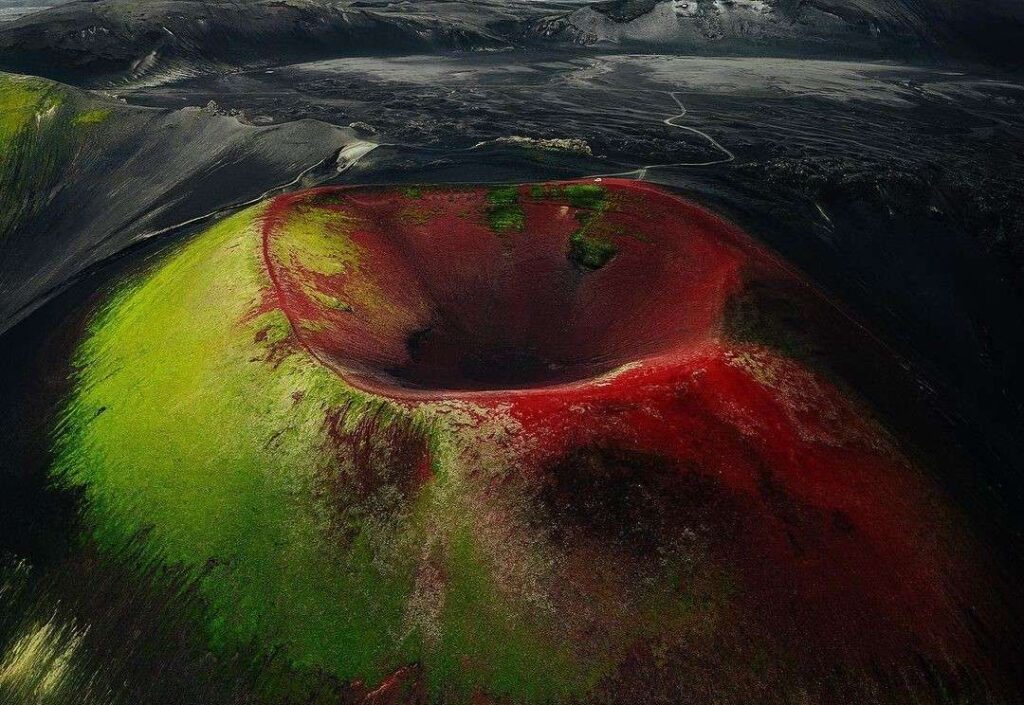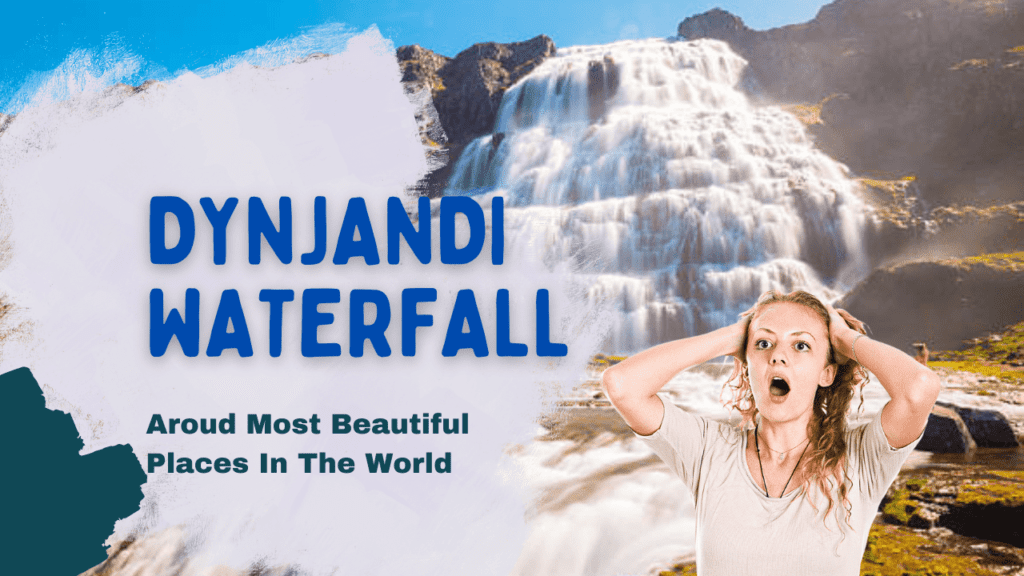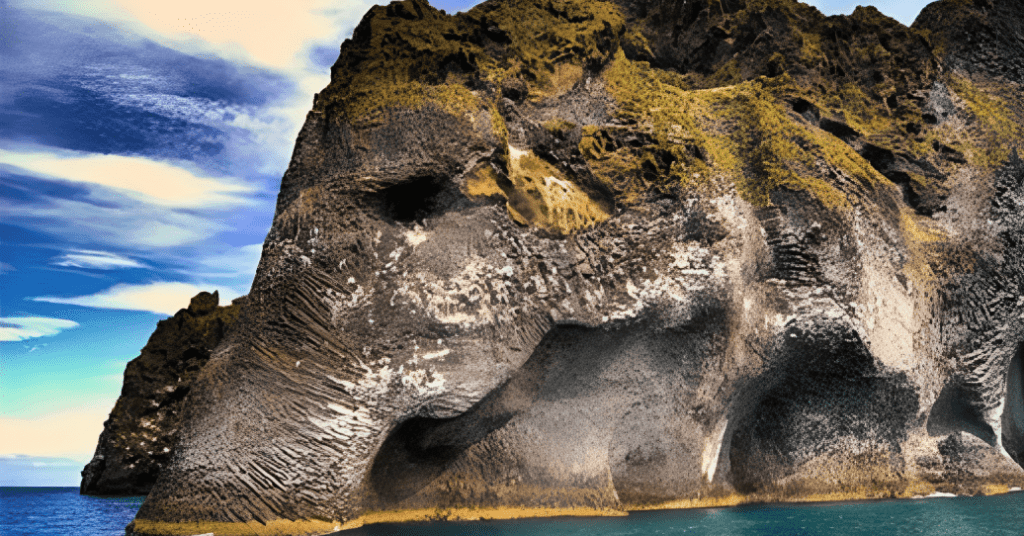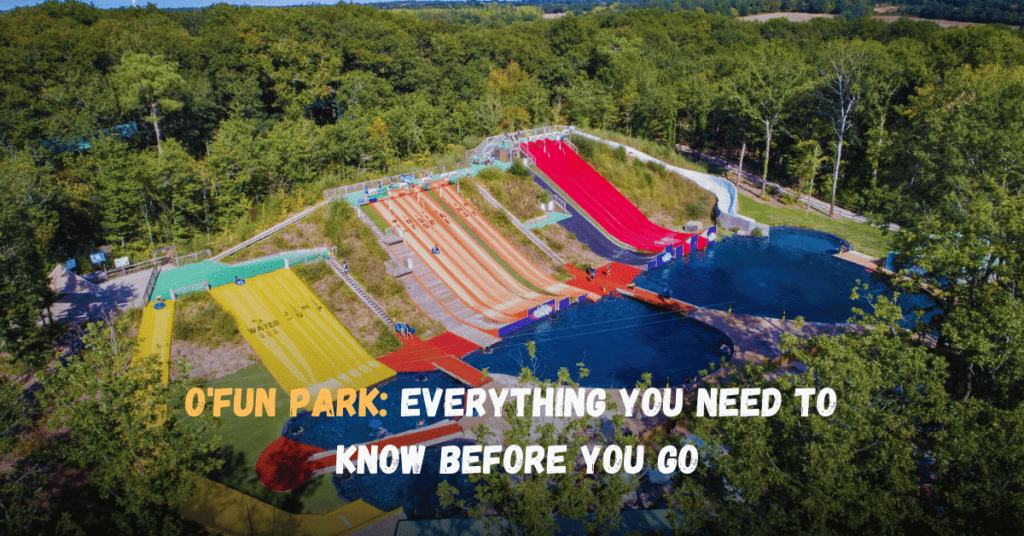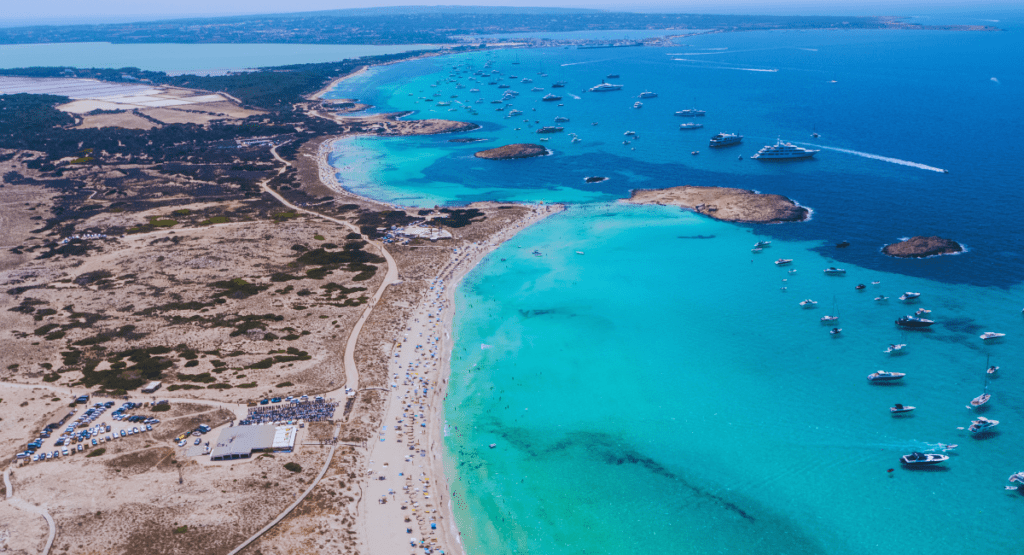
Welcome to Formentera, a hidden gem in Spain’s Balearic Islands! This small, beautiful island is perfect for those seeking a peaceful getaway with stunning beaches, clear waters, and a relaxed atmosphere. Whether you’re a nature lover, an adventure seeker, or someone who loves to soak up the sun, Formentera has something for everyone. In this guide, we’ll cover everything you need to know about visiting Formentera, including how to get there, the best attractions, and tips for a memorable trip.
Why Visit Formentera? What is Formentera Famous For?

Formentera is a special place known for its beautiful beaches and calm, clear waters. It’s a perfect spot if you want to relax and enjoy some peace and quiet. Unlike its lively neighbor Ibiza, Formentera offers a more laid-back experience, making it ideal for unwinding.
The island is famous for its amazing natural beauty. You’ll find miles of sandy beaches with soft, white sand and stunning blue waters that seem to go on forever. The coastline is untouched and lovely, with impressive cliffs and charming little villages that add to its appeal.
Formentera is also a top destination for people who love snorkeling and diving. The clear waters are home to lots of different marine animals and colorful underwater scenes, making it a fantastic place to explore beneath the surface. Whether you’re looking for a relaxing beach day or an exciting underwater adventure, Formentera has something special for everyone.
Where is Formentera Located?
Formentera is located in the Mediterranean Sea and is part of the Balearic Islands archipelago, which belongs to Spain Europe. It is situated south of its larger neighboring island, Ibiza, and is the smallest and southernmost island of the Balearic group. Formentera is known for its beautiful beaches, crystal-clear waters, and relaxed atmosphere, making it a popular destination for travelers seeking a quieter alternative to the more bustling Ibiza.
How to Get to Formentera
By Ferry The primary way to reach Formentera is by ferry from Ibiza. The ferry ride takes about 30 minutes, and several companies operate this route, including Med Pitiusa, Trasmapi, and Baleària. Ferries run frequently throughout the day, which makes it easy to plan either a day trip or a longer stay. Ticket prices typically range from €15 to €25 for a one-way trip, depending on the season and ferry company. It’s a good idea to book tickets in advance, especially during the peak summer months.
By Private Boat Charter For those seeking a more personalized experience, private boat charters offer direct transportation from Ibiza or other nearby locations. This option provides flexibility and can be a fun way to start your Formentera adventure with a scenic journey across the Mediterranean.
Traveling from Mainland Spain If you are traveling from mainland Spain, you can fly into either Ibiza Airport or Palma de Mallorca Airport. From Ibiza Airport, you can take a bus to the ferry terminal in Ibiza Town and then catch a ferry to Formentera. If you land in Palma de Mallorca, you would need to take a flight or ferry to Ibiza first before transferring to a ferry to Formentera.
Top Attractions in Formentera and Things to do in Formentera
Formentera, the smallest of Spain’s Balearic Islands, is a paradise for those seeking tranquil beaches, stunning landscapes, and a laid-back vibe. Here are the top attractions and things to do in Formentera:
1. Playa de Ses Illetes

- Why Visit: Playa de Ses Illetes is the crown jewel of Formentera’s beaches, often celebrated as one of the best in the world. Located on the northern coast of the island within the Ses Salines Natural Park, this beach offers an almost otherworldly beauty, with its fine white sand and water so clear that it seems almost invisible.
- Things to Do:
- Swimming and Sunbathing: The calm, shallow waters make it an ideal spot for swimming, while the soft sand is perfect for sunbathing.
- Snorkeling: The clarity of the water provides excellent conditions for snorkeling, where you can observe a variety of marine life including colorful fish and underwater plants.
- Dining: Beachside chiringuitos (beach bars) offer local delicacies such as seafood paella, allowing you to savor a meal with your toes in the sand. Keep in mind that prices can be high due to the beach’s popularity, so planning ahead or packing a picnic might be wise.
2. Es Cap de Barbaria Lighthouse

- Why Visit: Standing at the southernmost point of Formentera, Es Cap de Barbaria Lighthouse is an iconic symbol of the island. The remote location, surrounded by rugged cliffs and open sea, gives it a mystical and serene atmosphere.
- Things to Do:
- Photography: The lighthouse is a prime spot for photography, especially during sunrise or sunset when the light bathes the landscape in golden hues.
- Explore the Cova Foradada: Nearby, there’s a hidden cave known as Cova Foradada. A small, unmarked path leads to this natural wonder, where you can climb down into the cave and emerge on a cliffside opening with stunning sea views.
- Sunset Viewing: Watching the sunset here is a must-do. The sun dipping into the horizon with the lighthouse in the foreground is a sight that will leave a lasting impression.
3. Sant Francesc Xavier

- Why Visit: Sant Francesc Xavier, the capital of Formentera, offers a glimpse into the island’s history and culture. This small town is characterized by its charming whitewashed buildings, narrow streets, and relaxed atmosphere.
- Things to Do:
- Visit the Church of Sant Francesc Xavier: This 18th-century church, with its simple but elegant architecture, is a central part of the town. It also served as a fortress to protect against pirate attacks.
- Shopping: Explore the local shops that sell handmade crafts, clothing, and souvenirs. The town’s weekly market is also a great place to find unique items such as jewelry and artisan products.
- Dining and Cafés: Enjoy a meal or a coffee in the town square, where you can people-watch and soak in the laid-back vibe. The square is surrounded by several restaurants offering traditional Balearic cuisine.
4. La Savina Port
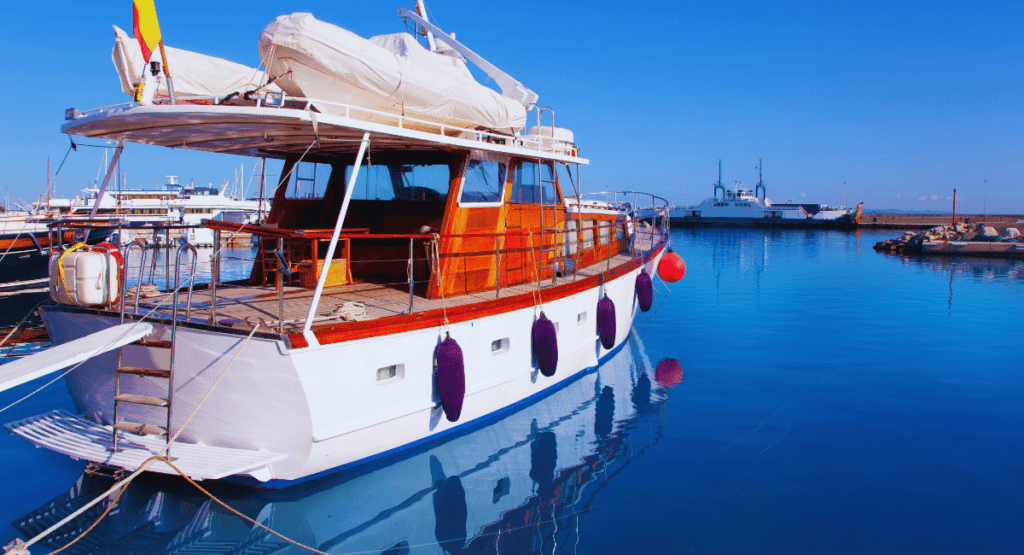
- Why Visit: La Savina is the gateway to Formentera, where most visitors first set foot on the island. This bustling port town is not just a transit point but a lively area with plenty of activities to start your adventure.
- Things to Do:
- Rent a Bike or Scooter: Formentera is a small island, and one of the best ways to explore it is by bike or scooter. Rentals are available right at the port, and it’s a popular option for those who want to experience the island at their own pace.
- Boat Tours: Consider taking a boat tour around the island or to nearby Espalmador Island. These tours often include stops for swimming, snorkeling, and exploring hidden coves.
- Explore the Salt Flats: The nearby salt flats of Las Salinas are a must-see, particularly at sunrise or sunset when the light reflects off the shallow water, creating a mirror-like effect.
5. Cala Saona
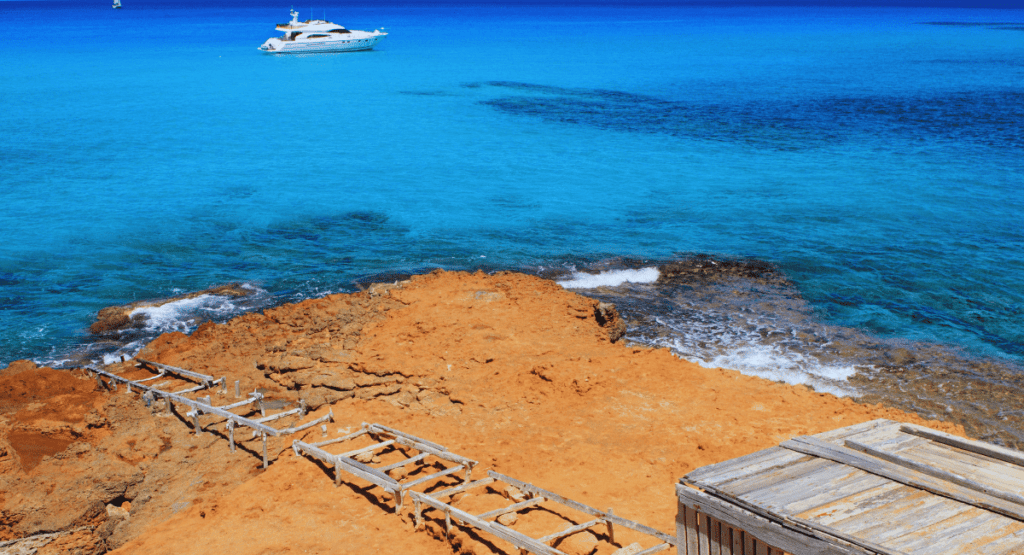
- Why Visit: Cala Saona is a hidden gem on the western coast of Formentera. This small cove is surrounded by red cliffs and pine trees, creating a striking contrast with the turquoise waters.
- Things to Do:
- Relax on the Beach: Cala Saona is less crowded than other beaches, making it a perfect spot to relax and enjoy the tranquility. The water here is calm and shallow, ideal for swimming.
- Cliffside Walks: For the more adventurous, take a walk along the cliffs that border the cove. The views from the top are breathtaking, especially during sunset.
- Paddleboarding and Kayaking: The calm waters of Cala Saona are perfect for paddleboarding or kayaking. Rentals are available on the beach, and it’s a great way to explore the coastline.
6. Es Pujols
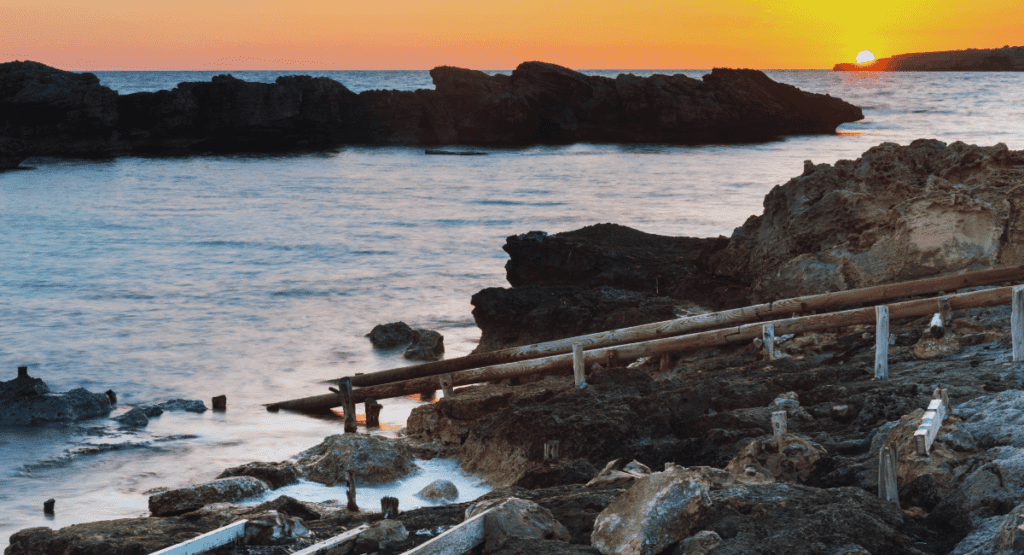
- Why Visit: Es Pujols is the main tourist hub of Formentera, known for its lively atmosphere, beautiful beach, and vibrant nightlife. It’s a great place to base yourself if you want easy access to both relaxation and entertainment.
- Things to Do:
- Water Sports: The beach at Es Pujols offers various water sports, including windsurfing, jet skiing, and parasailing. It’s a great spot for thrill-seekers.
- Dining and Nightlife: Es Pujols is packed with restaurants, bars, and nightclubs. Enjoy a meal at a seaside restaurant, where you can try local dishes like bullit de peix (a traditional fish stew), followed by a night out at one of the area’s clubs.
- Shopping: The town has a variety of shops selling everything from fashion to souvenirs. The nightly artisan market is a highlight, offering locally made crafts and jewelry.
7. Ses Salines Natural Park

- Why Visit: Spanning both land and sea, Ses Salines Natural Park is a UNESCO World Heritage site that stretches from Ibiza to Formentera. It’s a haven for wildlife and offers some of the most unspoiled landscapes on the island.
- Things to Do:
- Birdwatching: The salt flats are home to a wide variety of bird species, including flamingos, which can often be seen wading through the shallow waters. Bring binoculars for the best viewing experience.
- Hiking and Cycling: The park has several trails that wind through its diverse ecosystems, including salt flats, beaches, and forests. Hiking or cycling is a great way to explore the natural beauty of the area.
- Beach Time: Some of the island’s best beaches, including Playa de Ses Illetes and Playa de Llevant, are within the park. These beaches are perfect for a day of sun and sea, with fewer crowds than other areas.
8. Es Caló de Sant Agustí

- Why Visit: Es Caló de Sant Agustí is a quaint fishing village that offers a glimpse into Formentera’s traditional way of life. The village is known for its peaceful ambiance and stunning coastal views.
- Things to Do:
- Coastal Walks: The village is the starting point for a beautiful coastal walk along ancient Roman roads, known as the Camí de Sa Pujada. The path offers spectacular views of the sea and the island’s rugged coastline.
- Dine on Fresh Seafood: The village’s restaurants are famous for their fresh seafood. Enjoy a meal with the catch of the day, paired with local wine, while overlooking the harbor.
- Explore the Harbor: The small harbor is lined with traditional fishing boats, and it’s a lovely place to stroll and take photos. The village’s tranquility makes it an ideal spot to unwind.
9. Las Salinas Salt Flats

- Why Visit: The Las Salinas salt flats are a vital part of Formentera’s history and economy, and they create one of the island’s most visually striking landscapes. Located near La Savina, these salt flats have been in use since the 13th century.
- Things to Do:
- Guided Tours: Take a guided tour to learn about the salt production process and the ecological significance of the salt flats. These tours often include information about the flora and fauna that thrive in this unique environment.
- Photography: The salt flats are particularly photogenic, especially at sunset when the sky turns shades of pink and orange, reflecting off the shallow waters. This is a prime spot for landscape photography.
- Historical Insights: Learn about the role of salt in Formentera’s history, from its economic importance to its influence on local culture and cuisine.
10. Can Marroig Interpretation Center

- Why Visit: Can Marroig is an environmental education center that provides visitors with a deeper understanding of Formentera’s natural heritage. It’s located within a beautiful estate that includes woodlands, cliffs, and sea views.
- Things to Do:
- Explore the Exhibits: The center offers interactive exhibits on the island’s ecosystems, including its marine life, terrestrial habitats, and conservation efforts. It’s a great place to learn about the island’s biodiversity.
- Guided Nature Walks: The center organizes guided walks through the surrounding area, where you can learn about the local flora and fauna. These walks are ideal for families and nature enthusiasts.
- Relax in Nature: The estate’s grounds are a lovely place to spend a few hours. You can enjoy a picnic, take in the sea views, and explore the area’s natural beauty at your own pace.
Bonus: Boat Trips to Espalmador Island
Explore the Island: Though small, Espalmador offers opportunities for exploration. Take a walk around the island’s coast, enjoy the untouched scenery, and appreciate the feeling of being on a deserted island.
Why Visit: Espalmador is a small, privately-owned island just north of Formentera, known for its pristine beaches and untouched natural beauty. Although it’s private, visitors are allowed to access the beaches, making it a popular day trip destination.
Things to Do:
Relax on Secluded Beaches: Espalmador’s beaches are even more remote and tranquil than those on Formentera. The most famous beach, Playa de S’Alga, is a stretch of white sand with shallow, turquoise waters.
Swim in Natural Pools: The island is home to a series of natural mud baths, where visitors can cover themselves in mineral-rich mud before washing it off in the sea. It’s a unique and fun experience.
Best Activities to Experience in Formentera

Formentera is a paradise for those who love both relaxation and adventure. The island offers a wide range of activities that allow visitors to fully immerse themselves in its natural beauty and laid-back charm. Here are some of the best activities to experience in Formentera:
1. Beach Hopping
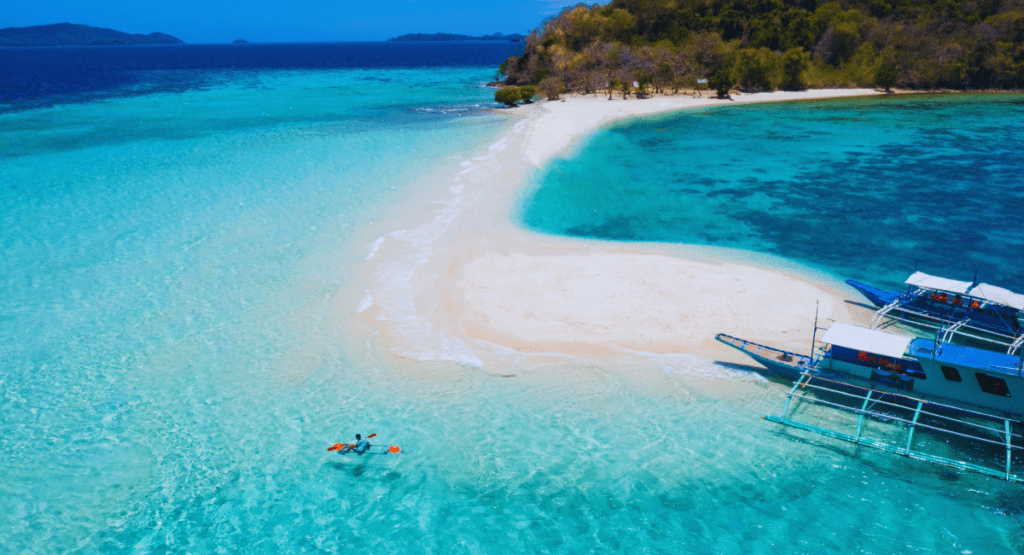
- What to Do: Formentera is home to some of the best beaches in the Mediterranean. Spend your days exploring different beaches, from the famous Playa de Ses Illetes to the more secluded Cala Saona. Each beach offers something unique, whether it’s powdery white sand, crystal-clear waters, or stunning sunsets.
- Top Spots: Playa de Ses Illetes, Cala Saona, Playa de Llevant, Es Arenals.
2. Snorkeling and Diving

- What to Do: The waters around Formentera are incredibly clear, making it a fantastic destination for snorkeling and diving. Explore the underwater world, which is teeming with marine life, including colorful fish, octopuses, and even the occasional dolphin.
- Top Spots: Punta Pedrera, Es Pujols, and Cala en Baster are known for their excellent snorkeling conditions.
3. Cycling Around the Island
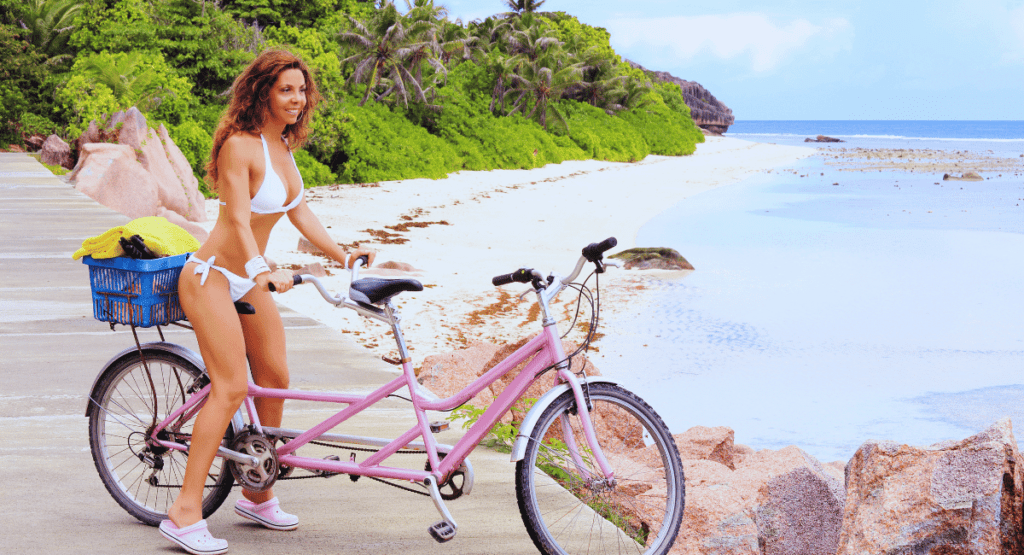
- What to Do: Formentera is a cyclist’s dream, with flat terrain and well-marked paths that make it easy to explore the island on two wheels. Cycling allows you to take in the island’s stunning landscapes at a leisurely pace, from salt flats and beaches to pine forests and quaint villages.
- Suggested Routes: The route from La Savina to Es Pujols, passing through the Ses Salines Natural Park, is particularly scenic.
4. Visit the Es Cap de Barbaria Lighthouse

- What to Do: One of Formentera’s most iconic landmarks, the Es Cap de Barbaria Lighthouse, is a must-visit. The lighthouse is perched on a cliff at the island’s southernmost tip, offering panoramic views of the sea. It’s also a great spot to watch the sunset.
- Bonus Activity: Near the lighthouse, explore the Cova Foradada, a small cave with a natural opening that offers breathtaking views of the sea.
5. Sunset Watching

- What to Do: Formentera is known for its stunning sunsets, and there are several spots around the island where you can watch the sun dip below the horizon. Bring a blanket, a bottle of local wine, and enjoy the show.
- Top Spots: Es Cap de Barbaria Lighthouse, Cala Saona, and Playa de Ses Illetes are popular places to catch the sunset.
6. Boat Trips and Sailing

- What to Do: Discover Formentera from the water by taking a boat trip or renting a sailboat. Explore hidden coves, visit the nearby island of Espalmador, and enjoy a day of swimming and snorkeling in the clear, turquoise waters.
- Highlights: Many boat tours offer stops at secluded beaches and include opportunities to snorkel or even try paddleboarding.
7. Explore Sant Francesc Xavier
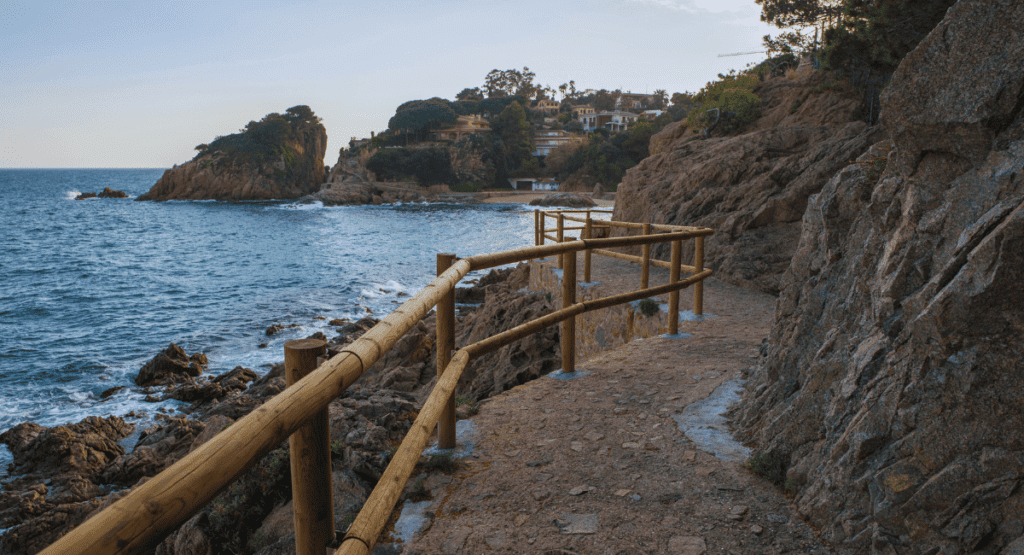
- What to Do: Spend a day in Sant Francesc Xavier, Formentera’s charming capital. Wander through the narrow streets, visit the 18th-century church, and explore local boutiques and markets.
- Don’t Miss: The town square is a great place to relax with a coffee or a meal, and it’s also home to the island’s main market, where you can find local crafts, food, and souvenirs.
8. Kayaking and Paddleboarding
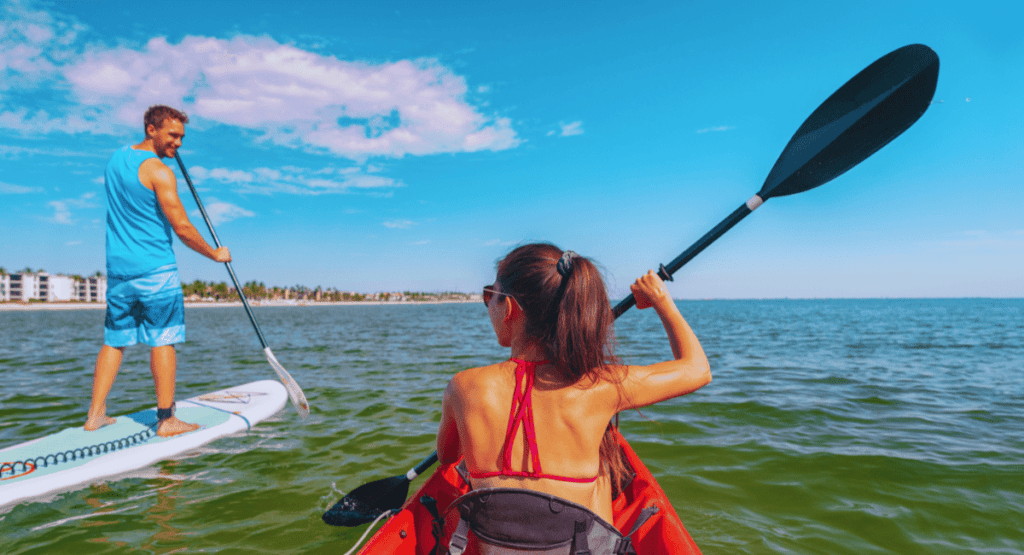
- What to Do: The calm waters around Formentera are perfect for kayaking and paddleboarding. Rent a kayak or paddleboard and explore the island’s coastline at your own pace, discovering hidden coves and beaches along the way.
- Best Areas: Cala Saona, Es Pujols, and the coast near La Savina are popular spots for these activities.
9. Birdwatching at Ses Salines Natural Park

- What to Do: If you’re a nature lover, head to Ses Salines Natural Park, a UNESCO World Heritage site. The park is home to a wide variety of bird species, including flamingos, which can often be seen wading in the salt flats.
- When to Go: Early morning or late afternoon is the best time for birdwatching, as the birds are most active and the light is ideal for photography.
10. Visit Es Caló de Sant Agustí

- What to Do: This picturesque fishing village is one of the most serene spots on the island. Walk along the old Roman paths, dine on fresh seafood at a local restaurant, and enjoy the peaceful atmosphere.
- Insider Tip: The village is also a great starting point for a coastal hike along the ancient Roman road known as the Camí de Sa Pujada, which offers stunning views of the sea and cliffs.
11. Experience Local Cuisine

- What to Do: Formentera’s culinary scene is deeply rooted in its Mediterranean heritage. Try local dishes like bullit de peix (a traditional fish stew) and frita de pulpo (fried octopus). Many restaurants on the island focus on fresh, locally sourced ingredients.
- Top Restaurants: Check out Can Rafalet in Es Caló for seafood, or head to Es Molí de Sal in La Savina for upscale dining with a view.
12. Attend Local Festivals and Markets

- What to Do: Formentera has a rich cultural calendar, with various festivals and markets taking place throughout the year. These events are a great way to experience local traditions, music, and cuisine.
- Don’t Miss: The artisan markets in La Mola and Sant Francesc are great for picking up unique souvenirs and enjoying live music in a festive atmosphere.
Here are some Top 10 Most Visited Countries in the World
Where to Stay in Formentera
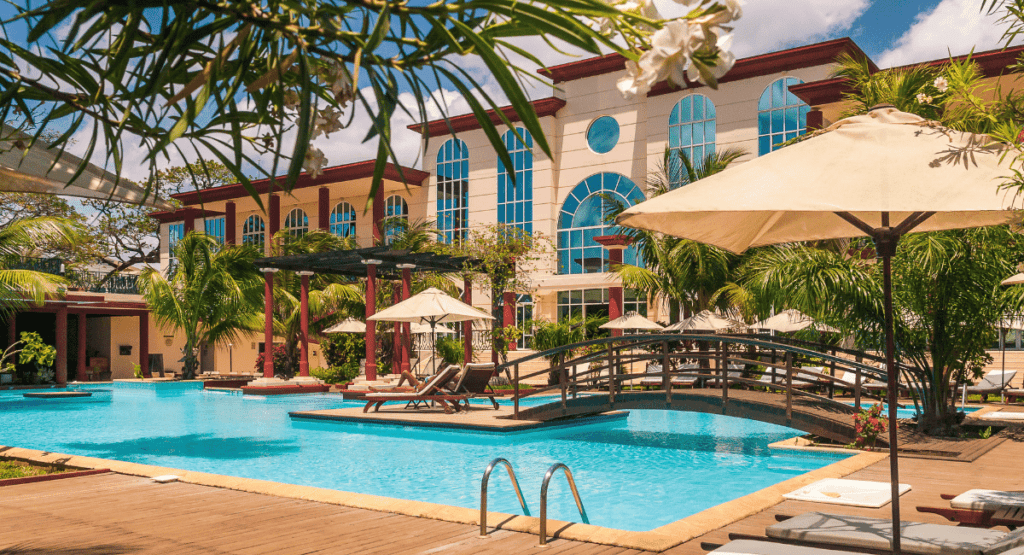
Choosing the right place to stay in Formentera depends on your preferences, whether you’re looking for a luxury retreat, a budget-friendly option, or a cozy boutique hotel. Here’s a guide to the best areas and accommodations on the island:
1. Es Pujols
- Why Stay Here: Es Pujols is the most popular tourist hub in Formentera, known for its lively atmosphere, beautiful beach, and vibrant nightlife. It’s the perfect base if you want easy access to restaurants, bars, and activities.
- Accommodation Options:
- Luxury: Hotel Lago Dorado – A beachfront hotel offering stunning sea views, a large pool, and upscale amenities.
- Mid-Range: Hotel Rosamar – A charming hotel with a relaxed vibe, just a short walk from the beach.
- Budget: Hostal Capri – A simple yet comfortable option, close to the town’s main attractions.
2. Sant Francesc Xavier
- Why Stay Here: Sant Francesc Xavier is the capital of Formentera, offering a more tranquil and authentic experience. It’s ideal for those interested in the island’s history and culture, with easy access to shops, restaurants, and the island’s main church.
- Accommodation Options:
- Luxury: Hotel Es Marès – A boutique hotel known for its stylish design, excellent service, and wellness spa.
- Mid-Range: Sa Pergola – A charming guesthouse offering comfortable rooms and a peaceful garden area.
- Budget: Hostal Illes Pitiüses – A family-run guesthouse with simple, clean rooms and a welcoming atmosphere.
3. La Savina
- Why Stay Here: La Savina is the port town where most visitors arrive by ferry from Ibiza. It’s a convenient base for those planning to explore the island by car or bike, with easy access to boat rentals and excursions.
- Accommodation Options:
- Luxury: Hotel Bahia – A stylish hotel with modern amenities and stunning views of the marina.
- Mid-Range: Hostal Bellavista – A comfortable option offering a restaurant, bar, and great views of the port.
- Budget: Hotel Lago Playa – A budget-friendly hotel close to both the port and the beach.
4. Playa Migjorn
- Why Stay Here: Playa Migjorn is the longest beach on the island, offering a more secluded and peaceful experience. It’s perfect for those looking to relax by the sea, with several beachfront accommodations to choose from.
- Accommodation Options:
- Luxury: Gecko Hotel & Beach Club – A chic beachfront property with a relaxed atmosphere, offering yoga classes, a pool, and gourmet dining.
- Mid-Range: Hotel Riu La Mola – A resort offering a range of amenities including a spa, two pools, and direct beach access.
- Budget: Insotel Club Maryland – An all-inclusive resort with bungalows, ideal for families and those on a budget.
5. Es Caló de Sant Agustí
- Why Stay Here: Es Caló de Sant Agustí is a quaint fishing village offering a quiet, authentic experience. It’s ideal for those looking to escape the busier areas and enjoy the natural beauty of Formentera.
- Accommodation Options:
- Luxury: Hotel Es Caló – A boutique hotel offering luxurious rooms with sea views, an infinity pool, and a gourmet restaurant.
- Mid-Range: Apartamentos Es Caló – A self-catering option with well-equipped apartments and easy access to the beach.
- Budget: Hostal Rafalet – A charming guesthouse with simple rooms and a popular on-site restaurant.
6. Cala Saona
- Why Stay Here: Cala Saona is known for its picturesque cove and stunning sunsets. It’s a perfect spot for those looking for a more romantic and secluded experience, with easy access to hiking trails and natural beauty.
- Accommodation Options:
- Luxury: Hotel Cala Saona & Spa – A luxurious retreat offering elegant rooms, a spa, and direct beach access.
- Mid-Range: Bungalows Es Pins – Comfortable bungalows set in a pine forest, offering a peaceful retreat close to the beach.
- Budget: Viviendas Turísticas Sa Cala – Budget-friendly apartments with kitchen facilities, ideal for longer stays.
7. La Mola
- Why Stay Here: La Mola is the highest point on the island, offering spectacular views and a more rural experience. It’s perfect for those interested in hiking, visiting the local market, and enjoying a quieter side of Formentera.
- Accommodation Options:
- Luxury: Hotel & Spa Can Talaias – A luxury retreat offering panoramic views, a beautiful garden, and a relaxing spa.
- Mid-Range: Casa Valentin – A charming rural guesthouse with cozy rooms and a friendly atmosphere.
- Budget: Hostal La Mola – A simple guesthouse offering affordable rooms and a convenient location near the local market.
Additional Tips:
Stay Environmentally Conscious: Many accommodations in Formentera focus on sustainability. Look for eco-friendly options and respect the island’s natural beauty by minimizing your environmental impact.
Book in Advance: Accommodations in Formentera, especially during peak season (June to September), fill up quickly. It’s advisable to book your stay well in advance.
Consider Renting a Vehicle: To fully explore the island, consider renting a car, scooter, or bicycle. This will give you the flexibility to visit different areas and beaches at your own pace.
Best time to visit Formentera

The best time to visit Formentera is generally considered to be during the shoulder seasons of May, June, September, and October. Here’s a breakdown of the information based on the search results:
Ideal Months to Visit
- May and June: These months are particularly favorable as the weather is warm and pleasant, with fewer crowds compared to the peak summer months. Many iconic places reopen during June, making it a vibrant time to visit with various activities available.
- September and October: These months also provide excellent weather, and the tourist crowds begin to thin out after the summer season. Visitors can enjoy the beaches and local attractions with more space and tranquility.
High Season
- July and August: These are the peak tourist months when Formentera experiences a significant influx of visitors. Prices for accommodations and services tend to rise, and the beaches can become quite crowded. If you plan to visit during this time, it’s advisable to book accommodations well in advance.
Weather Considerations
- Spring (April to June): This period marks the transition to warmer weather, making it an ideal time for beach outings and outdoor activities. The temperatures are generally mild, and the island begins to come alive with tourists and activities.
- Summer (June to September): Formentera shines during the summer with hot, sunny days and minimal rainfall. However, it can be crowded, especially in July and August, which may detract from the overall experience if you prefer a quieter atmosphere.
- Autumn (September to November): Early autumn still offers pleasant weather, but as the season progresses, temperatures drop and many tourist services may begin to close. However, it remains a beautiful time to enjoy the island without the summer crowds
Sustainable Tourism in Formentera
Formentera is committed to sustainable tourism to protect its natural beauty and environment. Visitors are encouraged to respect the local culture, minimize waste, and support eco-friendly practices, such as using reusable water bottles and bags. Many local businesses also participate in sustainability initiatives, so consider supporting these establishments during your stay.
Conclusion
Formentera is a true paradise for travelers looking for a peaceful escape with beautiful beaches, crystal-clear waters, and plenty of outdoor activities. Whether you’re planning a relaxing beach holiday, an adventurous trip, or a cultural exploration, Formentera has something to offer everyone. So pack your bags, hop on a ferry, and get ready to discover this stunning island in Spain!
Fequently Asked Questions
Is Formentera suitable for family vacations?
Yes, Formentera is great for family vacations. The island has a relaxed atmosphere, beautiful beaches with shallow waters, and a variety of family-friendly activities like cycling and exploring nature reserves.
Can I rent a car or scooter in Formentera?
Yes, you can rent cars, scooters, and bicycles in Formentera. Renting a scooter or bicycle is popular as it allows you to easily explore the island and access more remote beaches.
What is the currency used in Formentera?
The currency used in Formentera is the Euro (€).
Are there any special events or festivals in Formentera?
Formentera hosts several events throughout the year, including the Formentera Jazz Festival in June and the local fiestas celebrating the island’s patron saints in July and Aug
Why is Formentera so expensive?
Formentera tends to be more expensive due to its exclusivity and high demand, especially during peak tourist seasons. The island’s limited space for accommodations and its reliance on imports for goods contribute to higher prices. Additionally, Formentera’s commitment to maintaining its pristine environment and the relatively high cost of living in the Balearic Islands also play a role in driving up costs.
What should I pack for a trip to Formentera?
Pack light, breathable clothing, swimwear, sunscreen, a hat, and comfortable footwear for walking or cycling. If you plan to visit in the off-season, bring a light jacket for cooler evenings.
Is Formentera a good destination for solo travelers?
Yes, Formentera is a safe and welcoming destination for solo travelers. The island’s laid-back vibe, friendly locals, and beautiful landscapes make it a great place to explore on your own
Do I need to speak Spanish to visit Formentera?
While Spanish is the official language, many locals also speak English, especially in tourist areas. Knowing a few basic Spanish phrases can be helpful but is not essential.
Are there any eco-friendly options for exploring Formentera?
Formentera is committed to sustainability, and there are several eco-friendly ways to explore the island, such as renting an electric bike or car, staying in eco-friendly accommodations, and respecting the island’s natural environment.
Can I visit Formentera as a day trip from Ibiza?
Yes, Formentera is a popular day trip destination from Ibiza. Ferries run frequently between the islands, and you can explore Formentera’s beaches and attractions within a day.
Is it possible to camp in Formentera?
Camping is not widely available on Formentera as the island has strict regulations to preserve its natural beauty. Most visitors opt for hotels, guesthouses, or apartments.
What is the population of Formentera?
As of the latest data, Formentera has a population of approximately 12,000 (2018) residents. However, this number can increase significantly during the peak tourist season as visitors flock to the island.

